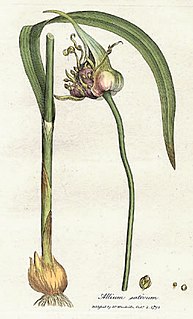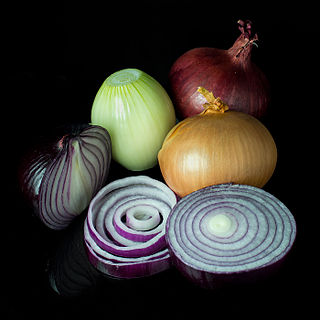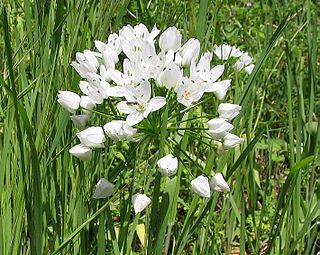Field garlic is a common name for several plants in the garlic genus, Allium :
- Allium oleraceum
- Allium vineale , native to Europe, northwestern Africa, and the Middle East
Field garlic is a common name for several plants in the garlic genus, Allium :

The shallot is a botanical variety of the onion. Until 2010, the shallot was classified as a separate species, Allium ascalonicum. The taxon was synonymized with Allium cepa in 2010, as the difference was too small to justify a separate species.

Garlic is a species of bulbous flowering plant in the genus Allium. Its close relatives include the onion, shallot, leek, chive, Welsh onion and Chinese onion. It is native to Central Asia and northeastern Iran and has long been used as a seasoning worldwide, with a history of several thousand years of human consumption and use. It was known to ancient Egyptians and has been used as both a food flavoring and a traditional medicine. China produces 76% of the world's supply of garlic.

The onion, also known as the bulb onion or common onion, is a vegetable that is the most widely cultivated species of the genus Allium. The shallot is a botanical variety of the onion which was classified as a separate species until 2010. Its close relatives include garlic, scallion, leek, and chive.

Allium ursinum, known as wild garlic, ramsons,wild cowleek, cowlic, buckrams, broad-leaved garlic, wood garlic, bear leek, Eurasian wild garlic or bear's garlic, is a bulbous perennial flowering plant in the amaryllis family Amaryllidaceae. It is native to Europe and Asia, where it grows in moist woodland. It is a wild relative of onion and garlic, all belonging to the same genus, Allium. There are two recognized subspecies: A. ursinum subsp. ursinum and A. ursinum subsp. ucranicum.

Allium tuberosum is a species of plant native to the Chinese province of Shanxi, and cultivated and naturalized elsewhere in Asia and around the world.

Allium tricoccum is a North American species of wild onion widespread across eastern Canada and the eastern United States. Many of the common English names for this plant are also used for other Allium species, particularly the similar Allium ursinum, which is native to Europe and Asia.

Allium vineale is a perennial, bulb-forming species of wild onion, native to Europe, northwestern Africa and the Middle East. The species was introduced in Australia and North America, where it has become a noxious weed.
Plant species in the genus Allium known as wild garlic include the following:

Allium canadense, the Canada onion, Canadian garlic, wild garlic, meadow garlic and wild onion is a perennial plant native to eastern North America from Texas to Florida to New Brunswick to Montana. The species is also cultivated in other regions as an ornamental and as a garden culinary herb. The plant is also reportedly naturalized in Cuba.

Allium neapolitanum is a bulbous herbaceous perennial plant in the onion subfamily within the Amaryllis family. Common names include Neapolitan garlic, Naples garlic, daffodil garlic, false garlic, flowering onion, Naples onion, Guernsey star-of-Bethlehem, star, white garlic, and wood garlic.
Wild onion can refer to

Allium nigrum, common name black garlic, broad-leaved leek, or broadleaf garlic, is a Middle Eastern species of wild onion. It lacks the onion or garlic scent shared by most of the other species in the group. The species is native to Turkey, Cyprus, Syria, Lebanon, and Israel but cultivated as an ornamental in many other places. It has become naturalized in some regions, including parts of the United States.
Oniongrass or onion grass may refer to:

Allium tuncelianum is a species of wild onion which is endemic to the Munzur Valley in Tunceli, in eastern Turkey.It usually produces a single-bulb white onion, unlike garlic, which has multiple bulbs. It has a garlic odor and taste and is used locally like garlic. Its common names include Tunceli garlic and Ovacik garlic. Botanists have suggested this species may be a close relative of garlic, and perhaps an ancestor of garlic, but genetic analysis shows that it is actually more closely related to leek. The plant is collected from the wild for use in cooking, a phenomenon that threatens the plant with extinction. It is known that Tunceli garlic shows higher antiradical activity and contains more total phenolic compounds than normal garlic. In addition, it is possible to say that Tunceli garlic is a better natural antioxidant than Kastamonu garlic. Tunceli garlic is single-toothed, has small tooth-like formations between its shells, has the familiar taste and aroma of garlic, unlike others, it can flower and give seeds. It has a chance to be used in consumption as well as in industry, due to its features such as being single-toothed, the number of shells being less compared to the cultivated garlic, and the storage of the head parts. It is stored for a long time at 18-20"C. It is collected from the mountains in the region and sold under the name of 'Rock garlic' and used as commercial goods. In an experiment conducted at Malatya Turgut Özal University, the effect of intraperitoneal injection of 1% and 10% doses of Tunceli garlic oil on some immunological factors of rainbow trout was evaluated. Rohu pups were fed a garlic supplemented diet for 60 days. This fish was then exposed to Aeromonas hydrophila by IP injection. Rainbow trout fry were fed garlic to groups for 14 days prior to intraperitoneal injection challenge with Aeromonas hydrophila per fish. In both of these studies, it was noted that fish fed garlic showed increased serum lysozyme and bactericidal activities and higher serum total protein.

Allium senescens, commonly called aging chive, German garlic, or broadleaf chives, is a species of flowering plant in the genus Allium.
White garlic may refer to:

Allium is a genus of monocotyledonous flowering plants that includes hundreds of species, including the cultivated onion, garlic, scallion, shallot, leek, and chives. The generic name Allium is the Latin word for garlic, and the type species for the genus is Allium sativum which means "cultivated garlic".

The leek is a vegetable, a cultivar of Allium ampeloprasum, the broadleaf wild leek. The edible part of the plant is a bundle of leaf sheaths that is sometimes erroneously called a stem or stalk. The genus Allium also contains the onion, garlic, shallot, scallion, chive, and Chinese onion. Three closely related vegetables, elephant garlic, kurrat and Persian leek or tareh, are also cultivars of A. ampeloprasum, although different in their uses as food.
"Onion weed" may refer to several species of plant that are either related to onions, have onion-like bulbs or flowers, or smell oniony or garlicky, and that are considered weeds outside their native ranges. These include:
Garlic common latent virus (GarCLV) is a plant virus member of the genus Carlavirus that has been found infecting garlic globally. Detection of the virus in leek and onion has also been reported.